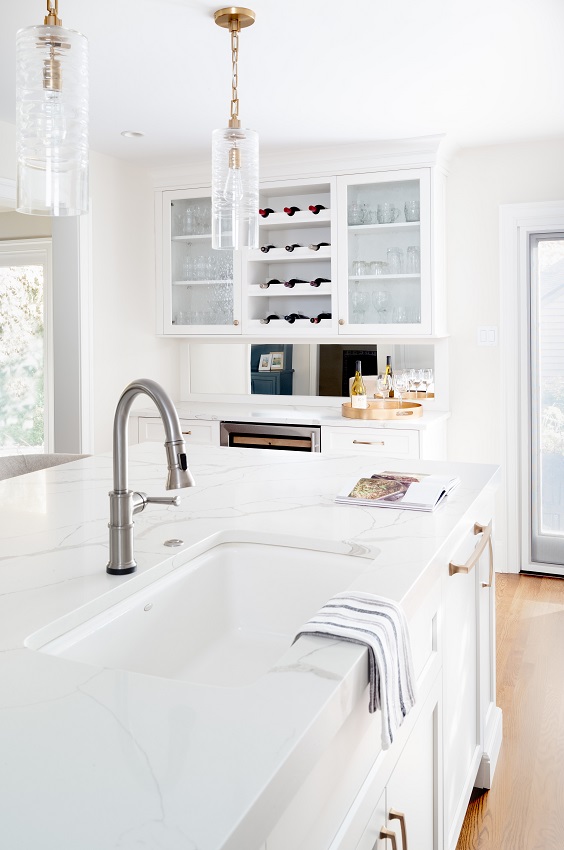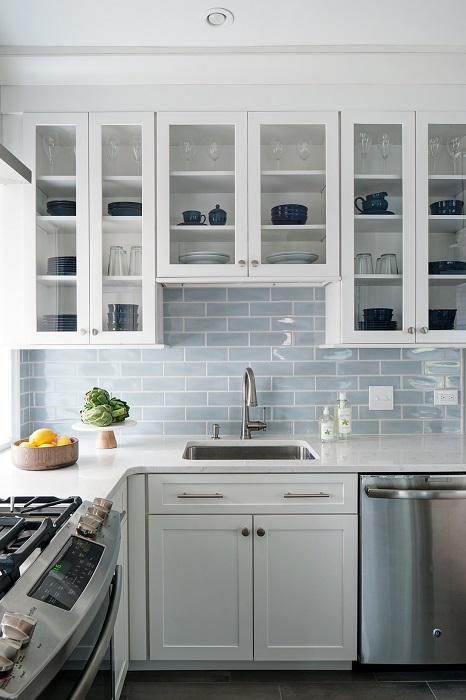
Choosing a kitchen sink material
When it comes to choosing a kitchen sink, there are several options for style and material. This week, we’re delving into the different materials that are available to choose from and which makes the most sense for you. We’ll talk about styles in an upcoming post as well!
Choosing a kitchen sink: what material is best for my needs?
Each of our kitchen designs is tailored to the client’s needs and wants. Therefore, selecting a kitchen sink very much depends on those factors, particularly lifestyle and aesthetic.
Stainless
Stainless steel is the most common choice for kitchen sinks, and for good reason. It’s classic, affordable, low-maintenance, and works in almost any style kitchen, from traditional to modern. Stainless steel’s resistance to heat works very well for hot cookware, but it can be scratched by tools or abrasive cleansers. “Gauge” refers to the steel’s thickness: the lower the gauge, the thicker the sink. This translates to both greater durability and more muffled sound; however, the thicker the sink, the more expensive it will be.
Enamel
An enamel sink is actually cast iron with an enamel coating. (Many cast-iron enameled sinks use recycled material!) Enamel ranks high on durability, although it is possible to chip the surface if it’s hit very hard. This choice is popular with many farmhouse-style kitchens, usually in an apron front design. Enameled cast iron also has versatility with regards to color; while white remains very popular, you can push the envelope with almost any shade.

Enameled cast iron sink in a Lafayette Hill kitchen by Glenna Stone Interior Design; photo by Rebecca McAlpin
Natural stone
Natural stone – like marble or soapstone – conjures feelings of refinement and luxury. These materials are often found on kitchen countertops and islands, but are also gaining popularity in sinks. A natural stone sink can be something of a work of art, carved, cut, and shaped to marry beauty and function. Some are farmhouse or prep sink styles, while others are fabricated from the same slabs as the countertops for a seamless, integrated design. To maintain a natural stone sink, use the same sealing procedure as stone surfaces for a long lifetime. How beautiful is this Arabescato Vaglia marble sink at Bluebell Kitchens?
Fireclay
Fireclay, a type of ceramic, has a similar look to enameled cast iron. However, fireclay is molded and then fired inside of a kiln over a period of time, which gives an impressive durability. One disadvantage of of fireclay is a susceptibility to cracking when exposed to vibrations, so you may opt for a different sink if you want an integrated garbage disposal.
Did you enjoy this dive into options for kitchen sink materials? We’d like to thank Meghan at our local Ferguson Bath, Kitchen & Lighting Gallery at King of Prussia for her expert assistance with this post!
Header image: Villanova kitchen by Glenna Stone Interior Design; Photo by Paul S. Bartholomew
Want our weekly blog post delivered right to your inbox? Click here to sign up!
________________________________________
Glenna Stone Interior Design is an award-winning Philadelphia interior design firm serving Philadelphia, the Main Line, and surrounding cities. Utilizing her background and training in interior design, architecture, and engineering, Glenna specializes in creating interiors for residential and commercial design settings. We invite you to visit our website, view our portfolio, and catch up on the latest interior design concepts on our blog!











